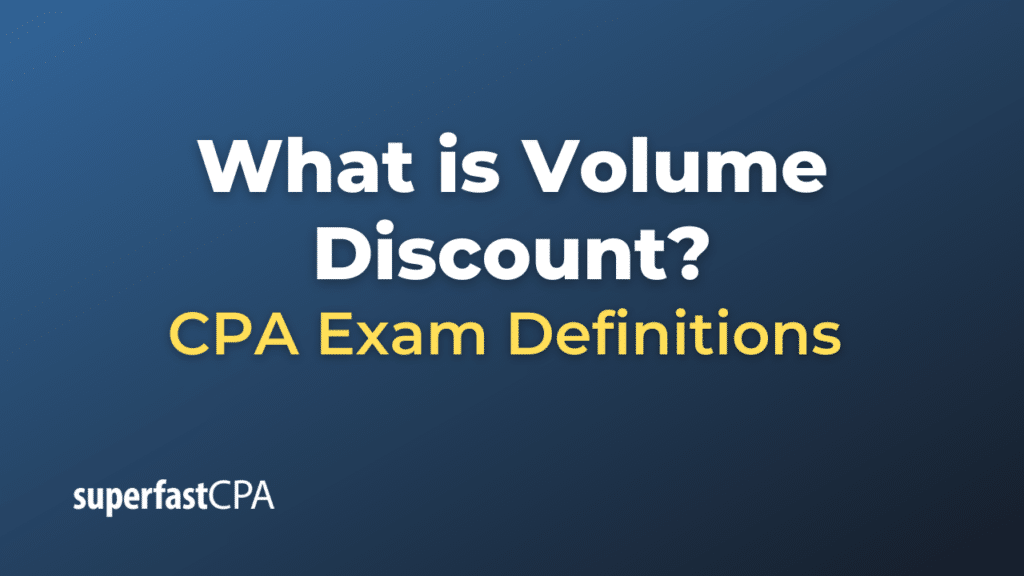Volume Discount
A volume discount is a pricing strategy where the per-unit cost of an item decreases as the quantity purchased increases. This approach is often used to incentivize customers to buy products in larger quantities, thereby increasing the overall sales volume. Volume discounts can be beneficial for both buyers and sellers. Buyers save money on each unit purchased, while sellers can move more inventory, reduce storage costs, and improve cash flow.
Types of Volume Discounts:
- Tiered Discounts: Different discount rates apply depending on the quantity purchased. For example, a customer might get a 5% discount when buying 50–100 units, a 10% discount for 101–200 units, and a 15% discount for 201 or more units.
- Cumulative Discounts: The discount is based on the total quantity purchased over a specific period. For example, a customer might earn a 5% discount on all orders after purchasing 1000 units over the course of a year.
- Package discounts: A fixed discount is applied when buying a pre-defined package or bundle of items, usually in large quantities.
- Early Payment Discounts : While not directly tied to volume, some companies offer a discount if large orders are paid for within a certain period (e.g., 2% discount if paid within 10 days).
How It Works:
- Pricing Structure: The seller establishes a pricing structure that outlines the discounts available at different quantities.
- Customer Order: The customer places an order, and the discount is applied based on the quantity or the terms agreed upon.
- Invoice and Payment : The seller issues an invoice reflecting the discounted price, and the customer makes payment accordingly.
- Delivery: The goods are delivered to the customer, often with economies of scale in shipping due to the larger volume.
Example of Volume Discount
Let’s use a fictional example featuring an electronics store called “Tech Haven” that sells smartphones. Tech Haven decides to offer a volume discount on a specific smartphone model to attract both individual and business customers.
Tech Haven’s Volume Discount Structure:
- Buy 1–4 smartphones: No discount, $800 per unit
- Buy 5–9 smartphones: 5% discount, $760 per unit
- Buy 10–19 smartphones: 10% discount, $720 per unit
- Buy 20 or more smartphones: 15% discount, $680 per unit
Scenarios:
Scenario 1: Individual Customer
- John, an individual customer, buys 3 smartphones for his family.
- Since John is buying fewer than 5 units, he doesn’t qualify for a volume discount. His total cost is 3 smartphones x $800 = $2,400.
Scenario 2: Small Business Owner
- Sarah, a small business owner, needs 8 smartphones for her team.
- Sarah qualifies for the 5–9 unit tier, so she receives a 5% discount.
- Her total cost is 8 smartphones x $760 (discounted price) = $6,080, compared to $6,400 without the discount.
Scenario 3: Corporate Purchase
- David, a procurement manager at a large corporation, needs to purchase 25 smartphones for his department.
- David qualifies for the highest discount tier, which offers a 15% discount.
- His total cost is 25 smartphones x $680 (discounted price) = $17,000, compared to $20,000 without the discount.
Financial Impact:
- For John: No discount applies, but he’s not purchasing in high volume anyway.
- For Sarah: She saves $6,400 (original cost) – $6,080 (discounted cost) = $320
- For David: He saves $20,000 (original cost) – $17,000 (discounted cost) = $3,000
Benefits for Tech Haven:
- Increased Sales Volume: By offering volume discounts, Tech Haven encourages customers to buy more units, thereby increasing overall sales volume.
- Attract Diverse Customers: The tiered discount structure makes the offer attractive to individual buyers, small businesses, and large corporations.
- Inventory Management: By moving more units quickly, Tech Haven can better manage its inventory and reduce storage costs.
- Customer Loyalty: Customers like Sarah and David are likely to return for future purchases, knowing that they can avail themselves of volume discounts.
This example demonstrates how volume discounts can benefit both buyers and sellers. Buyers enjoy a reduced per-unit cost, leading to overall savings. Meanwhile, the seller benefits from increased sales volume and potentially improved customer loyalty.













